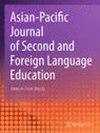特征上的语言依赖线索权重:来自英语母语者对普通话高元音感知的证据
IF 2.2
Q2 EDUCATION & EDUCATIONAL RESEARCH
Asian-Pacific Journal of Second and Foreign Language Education
Pub Date : 2023-09-15
DOI:10.1186/s40862-023-00204-6
引用次数: 0
摘要
摘要:本研究探讨了普通话中三个重音/i、u、y/在齿音、反折音和腭擦音和闪音(/s/-/ /-/ /;ʂ/ - / tʂ/ / tʂʰ/,/ʨ/,/ʨʰ/,/ɕ)由以英语为母语。知觉识别和分类实验结果表明,在三个目标元音中,高前圆元音/y/对英语母语者来说是最大的挑战。他们更容易混淆/y/和普通话高后圆元音/u/,而不是普通话高前圆元音/i/,因为他们在感知上将/y/和/u/归为同一个英语元音类别/u/。研究结果表明,以英语为母语的人采用的感知策略与以日语和韩语为母语的人不同,他们在感知普通话/y/时更依赖于圆的特征,而不是背的特征。本研究通过考察以英语为母语的人对普通话高元音语音线索(即显著特征)的权重,为感知线索权重领域做出贡献。这些结果具有重要的教学意义,因为它们强调了对不同语言背景的学习者进行有针对性的感知训练对于提高他们对第二语言语音的识别和再现的重要性。本文章由计算机程序翻译,如有差异,请以英文原文为准。

Language-dependent cue weighting in distinctive feature: evidence from the perception of Mandarin high vowels by native English speakers
Abstract This study investigates the perception of the three Mandarin high vowels /i, u, y/ after dental, retroflex, and palatal fricatives and affricates (/s/-/ʦ/-/ʦʰ/; /ʂ/-/tʂ/-/tʂʰ/, and /ʨ/, /ʨʰ/, /ɕ/) by native English speakers. The results of the perceptual identification and categorization experiments show that among the three target vowels, the high front rounded vowel /y/ presents the greatest challenge for native English speakers. They have a significantly higher tendency to confuse /y/ with the Mandarin high-back rounded vowel /u/ compared to the Mandarin high-front unrounded vowel /i/, as they perceptually classified /y/ and /u/ into the same English vowel category /u/. The findings of the study suggest that native English speakers adopt a perceptual strategy that differs from that of native Japanese and Korean speakers, relying heavier on the feature of roundness as opposed to backness in perceiving the Mandarin /y/. This study contributes to the perceptual cue weighting field by examining the weighting of phonetic cues (i.e., distinctive features) in Mandarin high vowels by native English speakers. These results hold pedagogical significance as they highlight the importance of targeted perception training for learners of different language backgrounds to enhance both their recognition and reproduction of second language sounds.
求助全文
通过发布文献求助,成功后即可免费获取论文全文。
去求助
来源期刊

Asian-Pacific Journal of Second and Foreign Language Education
Arts and Humanities-Language and Linguistics
CiteScore
2.90
自引率
5.60%
发文量
40
审稿时长
5 weeks
 求助内容:
求助内容: 应助结果提醒方式:
应助结果提醒方式:


